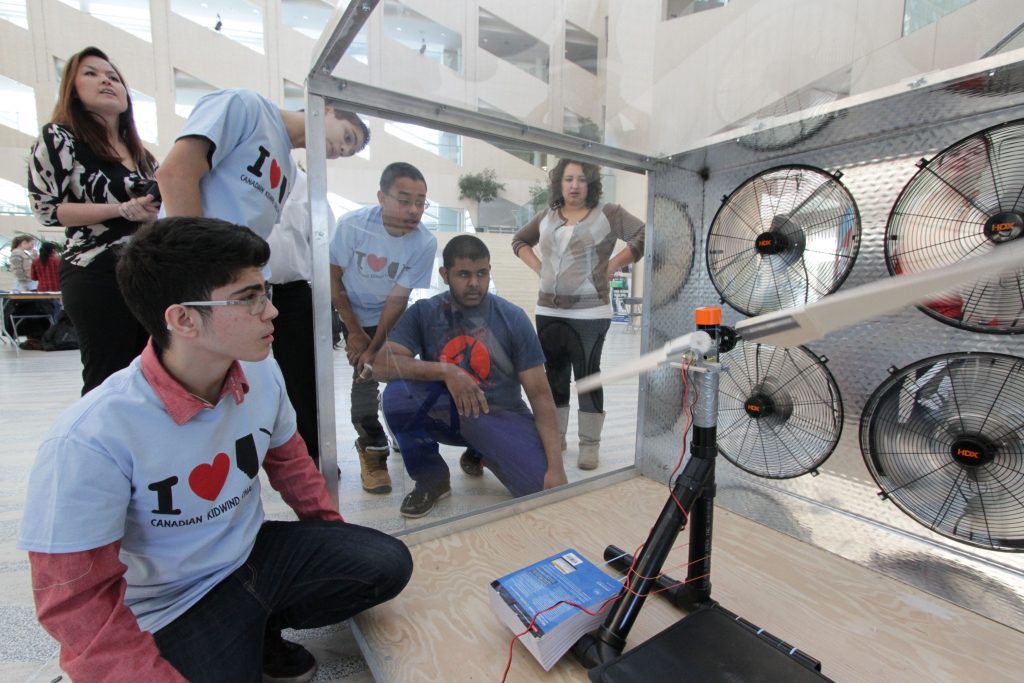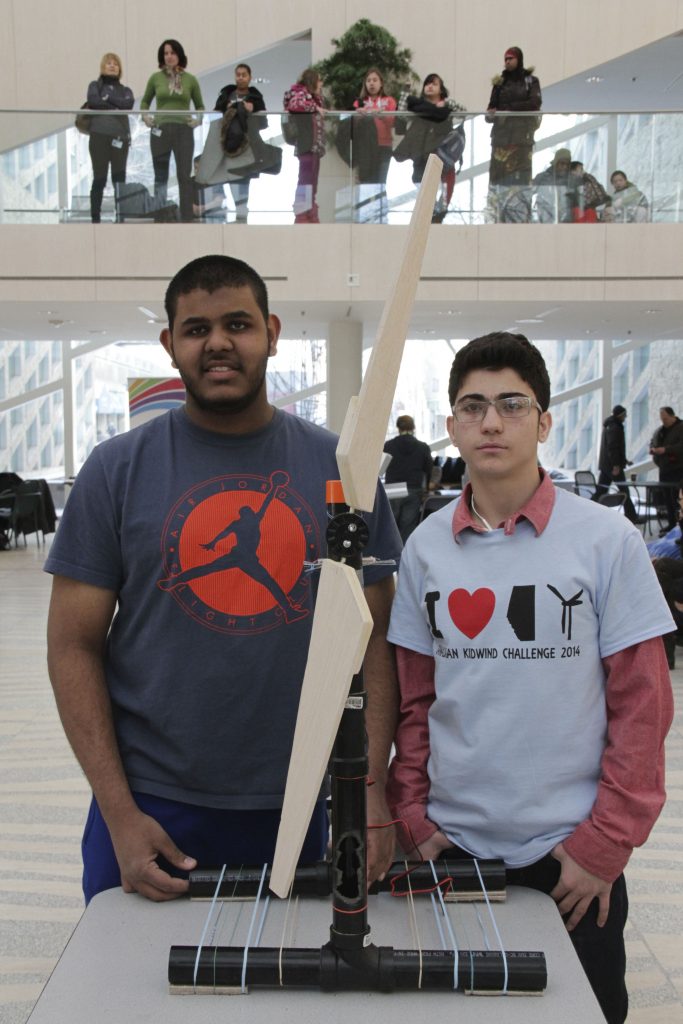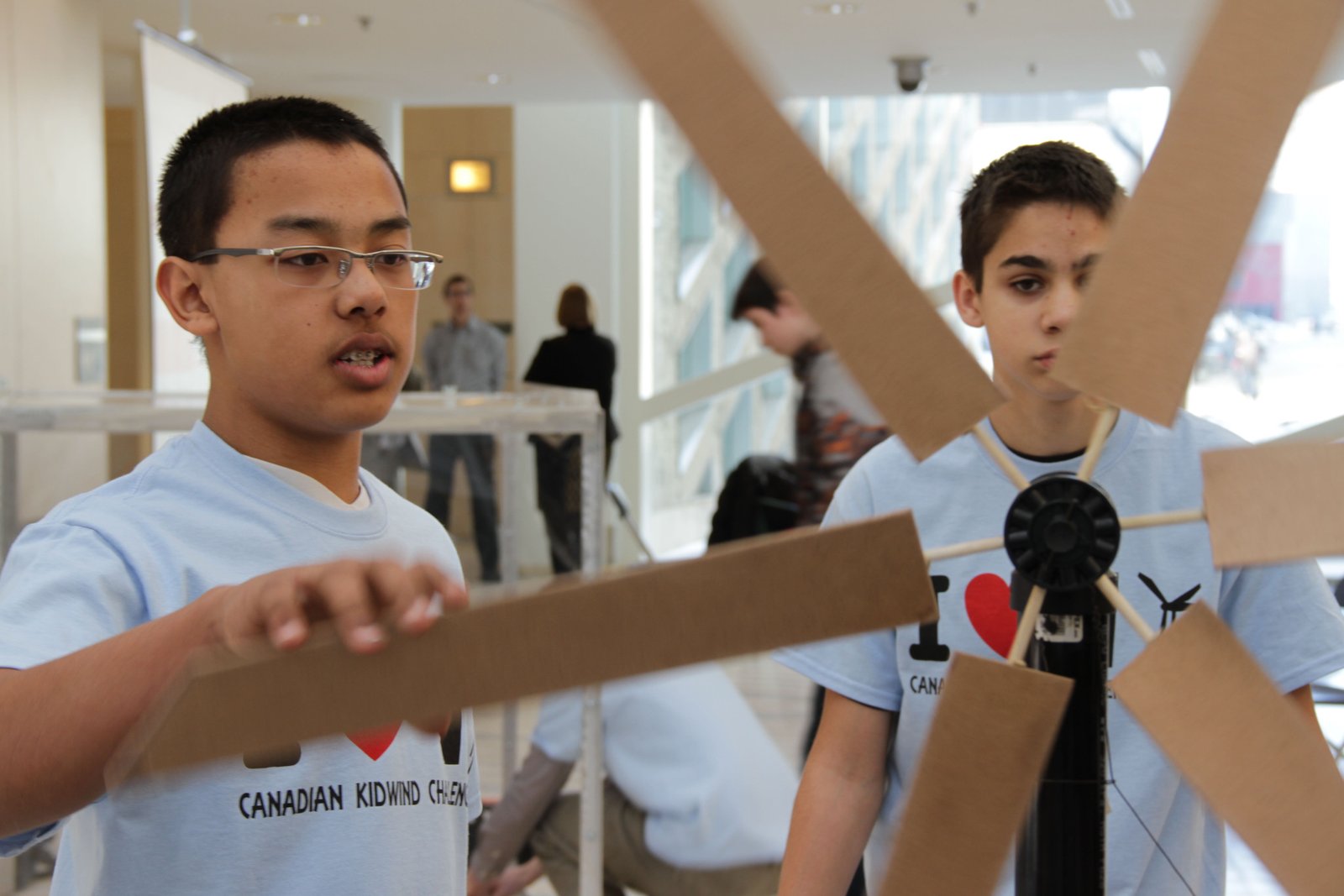By David Dodge and Duncan Kinney
The main room of Edmonton’s city hall is full of nervous energy as over 30 keen and green high school students eye up the competition, each team with their own two-foot tall wind turbine nearby. They’re participating in the KidWind Challenge and it’s a fun way to get students excited and involved with renewable energy.
Over 5,000 kids since 2009 from all over North America have participated in the KidWind Challenge designing and building micro wind turbines, testing them out in a wind tunnel and competing for prizes.
Colin Pishke is the project coordinator for the KidWind Challege and the wind energy community liaison with Lethbridge College a school with a wind turbine technician training program. He’s run three of these events in Alberta now and each time it gets bigger and better.

Team SLISE from Queen Elizabeth High School in Edmonton testing their wind turbine in the KidWind Challenge at Edmonton City Hal
“We’re trying to inspire the next generation of sustainable citizens and I think this is just one way that we’re able to accomplish that,” says Pishke.
Pishke says wind energy is exploding. In the early 2000s there was around 170 megawatts of wind. Now Canada is set to pass 8,000 megawatts of installed wind energy capacity this summer.
“So we’re seeing exponential growth and we need people to help build them, we need people to help maintain them. So it’s going very well both for our training and for the industry as a whole,” says Pishke.
Real world learning
As Queen Elizabeth High student Akeel Kahn explains the KidWind challenge was a chance to go beyond the theory in his textbooks: “Application and execution were new to me. It brought in the idea of how to put what we come up with in our heads into the real world, execute something and design it in real life, we had to overcome several barriers.”
Starting a small generator that came with their entrance fee the KidWind Challenge teams must research, design and build a two-foot wind turbine. They’re judged on electricity production, design, documentation and wind energy knowledge.
Seven teams from three high schools competed in the Edmonton KidWind Challenge. Each team gets two 60-second tests in the wind tunnel.

Akeel Kahn and Malek Hatamleh with their balsa wood wind turbine, the second place design at the KidWind Challenge in Edmonton.
Team Wind SLISE made up of Malek Hatamleh and Akeel Khan from Queen Elizabeth High School did their research and then made a two-blade wind turbine out of balsa wood and added in a sophisticated gear system to enhance energy production.
“We had to learn the concept of how the wind turbine actually works, says Hatamleh. “You don’t realize how much effort and how much design has to go into the blades themselves, the angle, the shape and all that stuff and especially the gear box that we had to build from scratch using our own gears and that took a lot of time and a lot of effort to increase the output.”
Hantamleh and Khan weren’t happy with their energy production after the first test in the wind tunnel so after discussing weight issues, surface area and angle of the blades they added a couple of extra blades and reduced the angle of the blades.
Rapid innovation is all part of the learning experience.
Meanwhile Team Tornado, Stephanie Reimer, Ceara Kelly, Neha Raina and Dhari Goswami, four young ladies from Hairy Ainlay High School opted for a different strategy.
When asked where their design came from Neha Raina had a good answer: “The Google thingy. It’s all in the Google thingy. But you research a lot and the KidWind site too, it really helped.”
Their extensive research and thorough testing produced a light, cardboard model wind turbine with perfectly shaped and angled blades.
When Team Tornado put their 2-foot wind turbine in the wind tunnel it went like crazy producing 392 milliwatts of electricity.
What was the secret? “I think the size, shape, number of blades and material really helped. We put four things together that really puzzled it out,” said Neha Raina.
The Tornadoes not only generated the most electricity in the wind tunnel tests but they also ended up winning the KidWind Challenge. Second place went to Team Wind SLISE.
But regardless of winners and losers, building a wind turbine from scratch is, by the student’s own assessment a great learning experience. When you take that two-foot wind turbine and scale it up to 80 meters you can just imagine the engineering and design tradeoffs you would have to make.
“We had to improvise a lot, we had to change our game plan so many times to get it to where we are today but overall it was a pretty good experience and I would be happy to do it again,” says Hatamleh.

